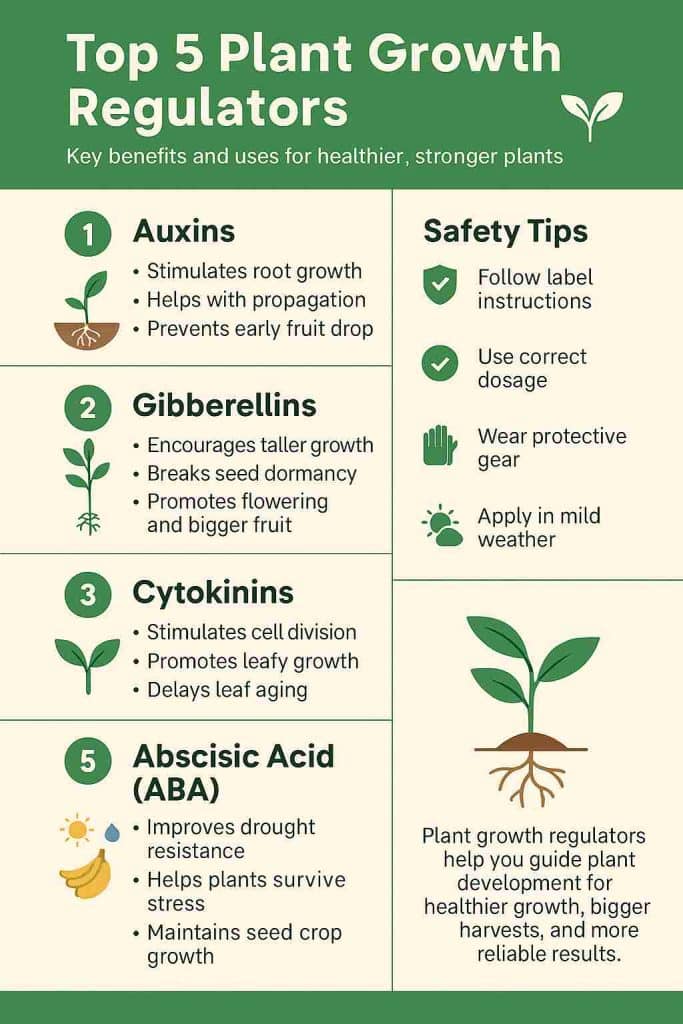The top 5 plant growth regulators are auxins, gibberellins, cytokinins, abscisic acid, and ethylene. These substances act like hormones inside plants and are used to guide growth, flowering, rooting, and ripening. They are valuable in gardening, farming, and landscaping because they help control plant development in a simple and predictable way.
Plant growth regulators can make roots form faster, improve flowering, delay fruit ripening for longer storage, or help plants survive stress such as drought. By understanding the top regulators and how they work, you can improve plant health, boost harvests, and get more consistent results whether you are growing crops or caring for a home garden.
Table of Contents
What Are Plant Growth Regulators?
Plant growth regulators, often called PGRs, are substances that influence how plants grow and develop. They act like natural plant hormones, but can be applied from outside to give plants a boost or correct growth patterns. While plants already make their own hormones, using PGRs allows gardeners, farmers, and landscapers to guide specific processes more effectively.
These regulators are especially useful for common needs such as encouraging roots to form on cuttings, delaying fruit ripening so produce lasts longer, keeping plants from growing too tall, or making sure flowers bloom at the same time for a uniform harvest. Because of their wide benefits, PGRs are used in agriculture, gardening, and even lawn and turf care to help achieve more consistent and reliable results.
1. Auxins – Best for Root Growth and Propagation
Auxins are one of the most important and widely used plant growth regulators because they control cell elongation, root initiation, and the overall direction of plant growth. They are especially helpful when propagating plants from cuttings, since applying auxins encourages strong root formation and increases the chance that new plants will survive and thrive. Gardeners also rely on auxins to stimulate healthier root systems in established plants and to reduce early fruit drop in crops. By supporting root strength and stability, auxin-based regulators give plants a solid foundation, making them more resilient and better prepared for healthy, long-term growth.
2. Gibberellins – Best for Taller Growth and Flowering
Gibberellins are plant growth regulators that stimulate stem elongation, seed germination, and flowering. They are often used by farmers when plants need an extra boost to grow taller, produce larger fruit, or overcome uneven growth. One of their most important roles is breaking seed dormancy, which helps seeds sprout more reliably. They are also valuable in crops like grapes and citrus, where they encourage flowering and improve fruit quality. For gardeners and farmers dealing with uneven germination, gibberellins can make a big difference by triggering more uniform sprouting, ensuring healthier and more productive plants.
3. Cytokinins – Best for Leaf and Shoot Growth
Cytokinins are known for promoting cell division, which results in more leaves, stronger shoots, and greener overall plant growth. They are especially helpful for leafy vegetables and plants that benefit from dense, healthy foliage. Another key role of cytokinins is slowing down the natural aging of leaves, allowing plants to stay healthier and look fresher for longer periods. In commercial farming and gardening, they are also used to extend the shelf life of harvested greens like lettuce, spinach, and herbs. By improving both plant vigor and post-harvest freshness, cytokinins offer gardeners and growers a reliable way to keep plants strong and market-ready.

4. Abscisic Acid – Best for Stress Resistance
Abscisic acid (ABA) plays a crucial role in helping plants survive stressful conditions such as drought, cold weather, or high salinity in the soil. Unlike regulators that encourage faster growth, ABA works by slowing growth and conserving energy when conditions are tough. This makes it especially valuable for improving drought resistance and preventing seeds from sprouting too early, which can harm crop success. Farmers in dry or unpredictable climates often rely on ABA treatments to help crops conserve water and maintain health until better conditions return. By reducing plant stress, abscisic acid helps ensure survival and stability during challenging weather.
5. Ethylene – Best for Fruit Ripening and Flower Opening
Ethylene is often called the “ripening hormone” because it plays a key role in bringing fruits to maturity. Farmers and distributors commonly use ethylene to control when fruits like bananas and tomatoes ripen, ensuring they arrive at markets in peak condition. It also encourages flower opening in ornamental plants and helps manage growth in cereal crops to prevent lodging, where stalks bend or collapse under their own weight. In commercial settings, ethylene is used to synchronize ripening so produce can be shipped and sold at the right time. For growers and sellers, it provides a practical way to deliver fresh, ready-to-eat products consistently.
How to Use Plant Growth Regulators Safely
Plant growth regulators are powerful tools, but they must be used carefully to avoid harming plants or the environment. The most important step is to always follow the directions on the product label, since different plants and growth stages require different concentrations. Using too much can damage leaves, stunt growth, or even kill the plant, while too little may not have any effect.
It’s also essential to handle synthetic regulators with care. Wearing gloves, masks, and protective clothing helps reduce exposure and keeps you safe during application. Timing matters as well, PGRs work best when applied in mild weather, so avoid spraying during extreme heat, heavy rain, or strong winds, which can reduce effectiveness and cause drift to unintended areas.
By applying the correct dosage at the right time and taking simple safety precautions, you can maximize the benefits of plant growth regulators while protecting both your plants and the surrounding environment.
Key Benefits of Using Plant Growth Regulators
The right PGR can transform how your plants grow. Here are the most common results you’ll see:
- Faster root development for stronger plants
- More uniform flowering and harvests
- Longer shelf life for fruits and vegetables
- Improved resistance to drought and other stresses
- Better control over plant size and shape
These outcomes save time, reduce waste, and improve overall plant performance whether you’re growing for your home garden, landscaping, or large-scale farming.
Final Thoughts
Plant growth regulators give you the ability to guide how plants grow and develop. The top 5 plant growth regulators are auxins, gibberellins, cytokinins, abscisic acid, and ethylene, each with an important role in plant success.
When used properly, they can improve plant health, boost harvests, and deliver more reliable results. Whether you garden at home or manage crops, understanding and applying these regulators is a simple way to help your plants thrive.
FAQs
What are the top 5 plant growth regulators?
The top 5 plant growth regulators are auxins, gibberellins, cytokinins, abscisic acid, and ethylene. They help control plant growth, flowering, ripening, and stress response.
Are plant growth regulators safe to use?
Yes, plant growth regulators are safe when used as directed. Always follow label instructions, apply the correct dosage, and handle them with basic protective gear.
Can I use plant growth regulators at home?
Yes, PGRs are used by home gardeners as well as farmers. They can help with rooting cuttings, keeping plants healthy, and improving harvests in small gardens.
Do plant growth regulators affect fruit taste?
No, when applied properly, plant growth regulators do not change the natural taste of fruit. They mainly influence growth, ripening, and shelf life.
What is the main benefit of using plant growth regulators?
The main benefit is better control over plant development, leading to healthier plants, bigger harvests, and more consistent results.
When is the best time to apply plant growth regulators?
The best time depends on the type of regulator. For example, auxins are applied during propagation, while ethylene is used closer to fruit ripening.
Do organic farmers use plant growth regulators?
Some natural PGRs, like seaweed extracts and certain hormones, are approved for organic use. Synthetic versions may not qualify under organic standards.




